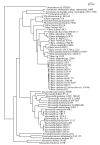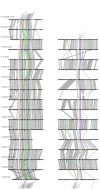Vibrio chromosomes share common history
- PMID: 20459749
- PMCID: PMC2875227
- DOI: 10.1186/1471-2180-10-137
Vibrio chromosomes share common history
Abstract
Background: While most gamma proteobacteria have a single circular chromosome, Vibrionales have two circular chromosomes. Horizontal gene transfer is common among Vibrios, and in light of this genetic mobility, it is an open question to what extent the two chromosomes themselves share a common history since their formation.
Results: Single copy genes from each chromosome (142 genes from chromosome I and 42 genes from chromosome II) were identified from 19 sequenced Vibrionales genomes and their phylogenetic comparison suggests consistent phylogenies for each chromosome. Additionally, study of the gene organization and phylogeny of the respective origins of replication confirmed the shared history.
Conclusions: Thus, while elements within the chromosomes may have experienced significant genetic mobility, the backbones share a common history. This allows conclusions based on multilocus sequence analysis (MLSA) for one chromosome to be applied equally to both chromosomes.
Figures




Similar articles
-
Genome-level homology and phylogeny of Vibrionaceae (Gammaproteobacteria: Vibrionales) with three new complete genome sequences.BMC Microbiol. 2013 Apr 11;13:80. doi: 10.1186/1471-2180-13-80. BMC Microbiol. 2013. PMID: 23578061 Free PMC article.
-
A global gene evolution analysis on Vibrionaceae family using phylogenetic profile.BMC Bioinformatics. 2007 Mar 8;8 Suppl 1(Suppl 1):S23. doi: 10.1186/1471-2105-8-S1-S23. BMC Bioinformatics. 2007. PMID: 17430568 Free PMC article.
-
Comparative genomic analysis reveals evidence of two novel Vibrio species closely related to V. cholerae.BMC Microbiol. 2010 May 27;10:154. doi: 10.1186/1471-2180-10-154. BMC Microbiol. 2010. PMID: 20507608 Free PMC article.
-
Vibrionaceae, a versatile bacterial family with evolutionarily conserved variability.Res Microbiol. 2007 Jul-Aug;158(6):479-86. doi: 10.1016/j.resmic.2007.04.007. Epub 2007 May 8. Res Microbiol. 2007. PMID: 17590316 Review.
-
Transcribing the enigma: the B chromosome as a territory of uncharted RNAs.Genetics. 2024 May 7;227(1):iyae026. doi: 10.1093/genetics/iyae026. Genetics. 2024. PMID: 38513121 Review.
Cited by
-
Phylogeny of Vibrio vulnificus from the Analysis of the Core-Genome: Implications for Intra-Species Taxonomy.Front Microbiol. 2018 Jan 5;8:2613. doi: 10.3389/fmicb.2017.02613. eCollection 2017. Front Microbiol. 2018. PMID: 29358930 Free PMC article.
-
Host, pathogen and the environment: the case of Macrobrachium rosenbergii, Vibrio parahaemolyticus and magnesium.Gut Pathog. 2016 Apr 25;8:15. doi: 10.1186/s13099-016-0097-1. eCollection 2016. Gut Pathog. 2016. PMID: 27114742 Free PMC article. Review.
-
Comparative Genome Analyses of Vibrio anguillarum Strains Reveal a Link with Pathogenicity Traits.mSystems. 2017 Feb 28;2(1):e00001-17. doi: 10.1128/mSystems.00001-17. eCollection 2017 Jan-Feb. mSystems. 2017. PMID: 28293680 Free PMC article.
-
Bacterial bioluminescence onset and quenching: a dynamical model for a quorum sensing-mediated property.R Soc Open Sci. 2017 Dec 13;4(12):171586. doi: 10.1098/rsos.171586. eCollection 2017 Dec. R Soc Open Sci. 2017. PMID: 29308273 Free PMC article.
-
Xer Site Specific Recombination: Double and Single Recombinase Systems.Front Microbiol. 2017 Mar 20;8:453. doi: 10.3389/fmicb.2017.00453. eCollection 2017. Front Microbiol. 2017. PMID: 28373867 Free PMC article. Review.
References
-
- Heidelberg JF, Eisen JA, Nelson WC, Clayton RA, Gwinn ML, Dodson RJ, Haft DH, Hickey EK, Peterson JD, Umayam L, Gill SR, Nelson KE, Read TD, Tettelin H, Richardson H, Ermolaeva MD, Vamathevan J, Bass S, Qin H, Dragoi I, Sellers P, McDonald L, Utterback T, Fleishmann RD, Nierman WC, White O, Salzberg SL, Smith HO, Colwell RR, Mekalanos JJ, Venter JC, Fraser CM. DNA sequence of both chromosomes of the cholera pathogen Vibrio cholerae. Nature. 2000;406:477–483. doi: 10.1038/35020000. - DOI - PMC - PubMed
Publication types
MeSH terms
LinkOut - more resources
Full Text Sources

